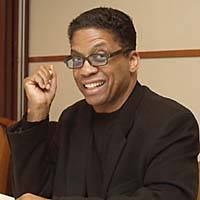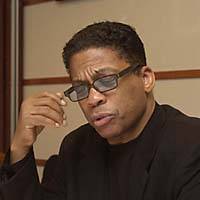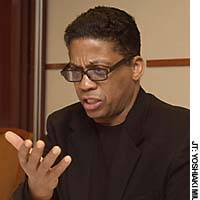Musicians can be extraordinary in so many different ways. John Coltrane was on a radical quest for enlightenment until the day he died. Bill Evans could voice chords in ways no one else ever imagined. Like a cat, Theolonius Monk could step off an edge and always land on his feet. And Miles Davis? You name it . . .
But what about Herbie Hancock? If he is extraordinary, what makes him so? Well, among other things, he's a rare creature who has been able to balance an incredibly prolific -- and profitable -- career as a straight-ahead jazz pianist with a technology-obsessed alter ego that is half man, half machine. Hancock first came to prominence with Miles Davis' band in 1963 and was an essential part of such albums as "ESP," "Nefertiti" and "In a Silent Way," among many others. He was also an influential player on Wayne Shorter's classics "Speak No Evil" and "Adam's Apple," to say nothing of his work with Donald Byrd, Roland Kirk, Lee Morgan, Freddie Hubbard -- the list goes on. And then there are his many albums as a leader that have yielded such jazz classics as "Watermelon Man," "The Sorcerer" and "Cantaloupe Island."
By contrast, on early '70s albums such as "Headhunters," "Sextant" and "Crossings," Hancock utilized advanced musical technology to express ideas that acoustic instruments alone simply could not. In 1983 he released "Future Shock," and for the album's hit single, "Rockit," Hancock appeared surrounded by robots in a bizarre, futuristic MTV video that stunned millions of viewers. "Rockit" not only introduced proto-turntablism and electronica to a mass audience, but by giving break dancers something to spin about, it also garnered Hancock something most aging jazzmen only dream of -- a young audience. 2001's "Future 2 Future," Hancock's exploration of club and world music, shows that the man's innovations continue.
That said, Hancock has increasingly relied on the hungry ears of younger musicians to stay on the cutting edge. Although he can still popularize unconventional music, it has been a while since he's been the inspiration behind it. For example, Bill Laswell created the format for "Future 2 Future," chose the musicians and recorded the tracks, and only when the material was nearly finished did Hancock lay down keyboards. On "Future Shock," Hancock utilized Laswell in a similar fashion, the elder pianist learning from the younger producer what was new in the world of music.
Last week, Hancock was in Tokyo and Osaka for his Directions in Music tour and to speak at the Foreign Correspondents' Club of Japan about a jazz event being organized by the Tokyo Jazz Secretariat, an arm of NHK Enterprises 21, Inc.
The fit, nattily dressed 63-year-old keyboardist frequently broke into a childlike grin as he openly discussed his formative experiences with Miles Davis, some of the crucial decisions he's made throughout his career, his embrace of Soka Gakkai International and his ever-present fascination with technology. Throughout the 40-minute interview, Hancock often paused for long intervals before answering a question and, at times, would trace patterns on the table in front of him, externalizing his thoughts before finding the language to express them.
Open ears
Describing the early formation of his "self," Hancock says that "One of the strongest influences I had was Miles Davis. The kind of openness that he had." As he speaks Davis' name, Hancock's eyes light up beneath his tinted designer eyewear, the mere thought of Davis still an inspiration after all these years.
"When I first joined Miles' group, I wasn't very open about music," he continues. "I was into jazz and I was into classical music. I didn't pay any attention to rock and roll or rhythm and blues." Weighing his words a moment, Hancock presses onward: "There was a good effect from this -- it meant that I was really concentrated on jazz. But the bad thing about it is that I wasn't open. But then I noticed that Miles was listening to everybody, and Miles" -- Hancock warmly draws out the M in Miles' name -- "was the epitome of being cool. And I said, if Miles is listening to everybody, then what's wrong with me?"
Hancock also honors Davis for having had the courage to learn from the young musicians who formed his various bands. "I drew a lot of strength from my experience with Miles because I saw what courage was. He showed it every time he picked up his horn. He showed it by the way he listened to the young musicians he was working with.
"He wasn't always just standing up there showing us how to play. He'd listen to what we did -- and we could tell he was listening because we could hear that his playing reflected the way that I had played or some ways that Tony Williams had played . . . or Ron Carter played . . . It seemed almost automatic, this genius for being able to absorb the ideas and concepts that were [still] unformed by his musicians. He would play in such a way that would clarify these ideas. And it always blew my mind."
(In his autobiography, Davis pays tribute to this band in this anecdote: "A lot of times on the road, there would be this knock at my hotel door, and there would be one of these bad young motherf**kers standing there, with a whole bunch of new tunes for me to look at. They'd hand them to me and walk away, like they were scared. I used to think to myself, What the f**k these motherf**kers scared of, bad as they are?")
Having learned lessons that could only come from the intimacy of being in a band that develops over time, Hancock faced a dilemma when considering the future of his own solo career. "There was a period of time when I had to decide whether I would have a group that would stay together a long time and grow together," he explains. "But I decided early on that I would like to have the flexibility to hire musicians for the different kinds of music that I might want to explore, rather than have jazz musicians trying to play a music that they're not familiar with and maybe that they're not quite equipped to do."
Hancock's flexibility allowed him to assemble the band that recorded "Headhunters," his second attempt at a funk record (he regards the first attempt as a disaster and killed it before it could be released). The success of this band is legendary but, at the same time, it forced Hancock to face another major question: how to handle the vitriol being spewed by conservative jazz critics -- criticism of "Headhunters" that could affect his sizable jazz following.
Acknowledging this dilemma, Hancock says, "I had a choice of either seeing that [criticism] as my problem or seeing it as their problem. I realized I didn't have a problem with making the [kind of music] that I had made. I decided to go in that direction from a standpoint that was very honest and very musical, and rather than assume that I had made a mistake, I realized that many of those critics have a problem with the narrowness of their viewpoint. It doesn't mean they have to like the record. But the kind of criticism I was getting was that I wasn't supposed to do that kind of record." He takes a long pause and then says, "Who -- who has the right to tell me what I'm supposed to do, you know?"
Path of enlightenment
Hancock credits Davis with having "planted a seed" that gave him the courage to have faith in his own judgment. However, not long after "Headhunters" appeared, Hancock also began drawing strength from a new source -- Soka Gakkai International, an organization of lay Buddhists that views Buddhism as a vehicle for personal empowerment. Hancock maintains that practicing Buddhism has taught him to find unity in the seemingly disparate elements of the world. He also insists that Buddhism is very much akin to jazz.
"One of the reasons why I accepted the practice of Buddhism was because it very much coincided with things that I was already learning in life through Miles and through the great example that jazz itself is, which is a model for a democratic and humanitarian viewpoint." Adding to that, Hancock also believes that Buddhism has helped him "think outside the box of jazz so that I can come up with solutions that I wouldn't have come up with had I still been inside that" -- he repeatedly traces squares on the table in front of him -- "box."
As evidence of his liberated thinking, Hancock points to the path he followed in recording four of his most recent albums.
"I did an album called 'Dis Is Da Drum' that has African influences, some orchestral things, there's funky stuff -- it's a lot of different things.
"And then the next record was called 'The New Standard.' [This album] was my attempt to treat the music written by pop composers of this day the way jazz artists used to treat pop tunes of the '30s -- you know, turn them into jazz songs. Then I did a [duet] record with Wayne Shorter. And, you know, the normal approach would have been, if there's only a saxophone and a piano that means it's like a four-piece group with two pieces missing -- the drummer and bass player aren't there, so we have to compensate. That's one way to look at it. But we decided that there's nobody missing! And we were able to do all kinds of things that we couldn't have done otherwise. That was totally different from anything I had done before.
"And then I did 'Gershwin's World' and that was a hard one because every piece of that record has a different concept -- it's not just that the record had a different concept. Each tune was like making a different record.
"And then 'Future 2 Future,' thanks to Bill Laswell, and his introducing me to some musicians who had been influenced by stuff I had done in my avant-garde period. The interesting thing was that I felt very comfortable with the things that they created because in many cases it kind of reminded me of the kinds of things I would have been attracted to back when I made 'Mwandaishi' and 'Crossings' and 'Sextant' "
Rhythm of life
While Hancock has successfully been inhabiting his dual musical personality for decades, he says that he consciously struggles to maintain a balance between man and machine. "It's something I thought about very early in the game -- that I didn't want the technology to rule, to be the guiding factor. And it's something that I have had varying degrees of success with. Sometimes maybe I become too swayed by the technology and go a little bit too far in that direction."
If Hancock is aware that technology can have too much influence on music, he's frustrated by its lack of influence on the problems that face disenfranchised people. Hancock says he "began to realize that the people who were creating the technology were being blinded by how much the advancements in technology would be able to help humanity. They had a very general viewpoint, but they certainly weren't looking at the details and they certainly weren't looking at the problems."
In response, Hancock established the Rhythm of Life Foundation in 1996. The foundation has two divisions, one for consulting and the other for education. The consulting division plans to replicate the Manchester Craftsmen Guild -- a state-of-the-art, world-class community resource center in Pittsburgh, Pa. -- in select cities around the world. The first replica will open sometime this year in San Francisco. Meanwhile, the education division creates curricula for kids in urban schools, focusing on technological proficiency that is, in essence, a valuable form of job training.
"[I] collect money from wherever I can get it and use it to reward individuals and companies that are using technology in ways that respond to the real problems that human beings face," he says.
And so Hancock's extraordinary career in music has led him to a second stage in life: giving others the chance to be extraordinary, too.




















With your current subscription plan you can comment on stories. However, before writing your first comment, please create a display name in the Profile section of your subscriber account page.